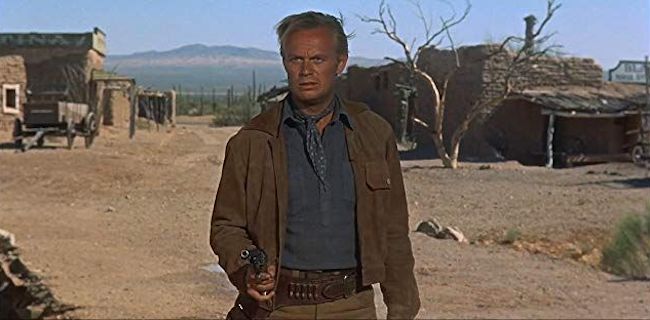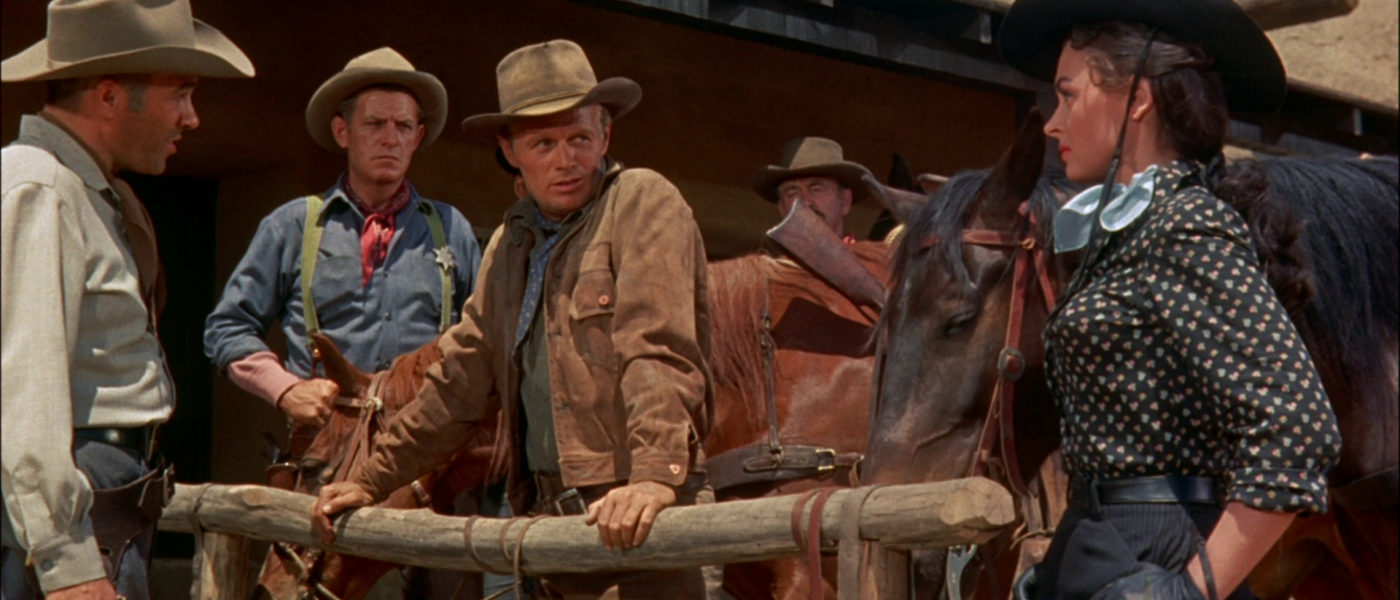Richard Widmark and Donna Reed Ride Into Psychological Action Western
DIRECTED BY JOHN STURGES/1956
BLU-RAY STREET DATE: AUGUST 18, 2020/KL STUDIO CLASSICS

It’s hard to know why John Sturges’ 1956 psychological Western Backlash is called “Backlash”. Could it be in honor of the telltale horse whip wielded by leading lady Donna Reed? Could it be due to the sharp-spinning sharpshooting of the main character played by Richard Widmark? Or could it for some altogether different reason? Whatever the case, it’s somewhat unfortunate that the film got saddled with such a generic title. It’s got far too much going for it in terms of both satisfying Western action and unique plot elements all its own.
Intrepid in its dustiness and never not soulfully remote, it may occur to contemporary viewers that the first half of Backlash could, with only minor Star Wars tweaking, be an episode of The Mandalorian. It begins with Widmark’s character Jim Slater, alone in the rocky desert, being confronted by a high-riding woman with a whip, predictive of Barbara Stanwyck in Sam Fuller’s Forty Guns (an even bolder Western that would open the following year). Clad in black leather and demanding cigarettes, she exudes a bad-girl smolder that even ultra-cool Widmark can’t resist. What brings her out into these parts alone? She’s mysterious. She’s sexy. She’s… Donna Reed??
Yes, Donna Reed, of It’s a Wonderful Life and The Donna Reed Show fame. Her character, Karyl Orton, with her not-so-veiled illicit appetites and exhibitionist tendencies (she goes out of her way to change her top in front of Slater), is certainly a far cry from the squeaky-clean reputation Reed left us with of herself. In a film with no shortage of fascinating elements, Orton is perhaps the most fascinating. This being a 1950s Western, she does of course morph into wearing long dresses and eventually desires monogamous stability. As unmotivated as her transformation might be, Reed nonetheless sells her character’s every curve. (Which, in a different sense, is another implied past transgression of Orton. It’s not easy for a woman to survive on her own in the West in wartime. Backlash takes place after the U.S. Civil War).

Both Orton and Slater assume that the only reason the other would venture to these parts alone would be for a rumored lost cache of gold. But that’s not really it. Moments after they make each other’s acquaintance, an unseen gunman starts shooting at Slater. This incident leads Slater back into town for answers, as we all the while slowly learn some of his own. Things develop from there in every way, even as the previous rapid clip of the action slows perhaps too much.
In her newly recorded audio commentary, Film Historian Samm Deighan discusses how Widmark’s Film Noir image plays so well into this role. In true Noir fashion, when it all comes down to it, Backlash is the story of one man’s world gone completely wrong. It just happens to be a Western– and a pretty good-looking one, at that. This new Blu-ray edition from KL Studio Classics shows off its era-specific rugged Technicolor charms. Aside from the usual array of related trailers, the commentary is the only bonus feature. It is more than enough, as listening to Deighan take us through a film is like attending a really engaging academic lecture. She is the Film History instructor you want.

There’s one more reason why Backlash might be called “Backlash”, one that ventures into spoiler territory. As to not completely dismantle anyone’s first viewing of this sixty-plus-year-old fairly obscure Western, the particulars of those revelations are left out of this review. Some very particular themes emerge, though- the kind that define classic Star Wars far more so than The Mandalorian. (At the time of this writing, the great Disney+ series is beginning its second season). Though director John Sturges would go on to be remembered for the lesser Western The Magnificent Seven (1960), the mark that Backlash leaves is all the more magnificent.


